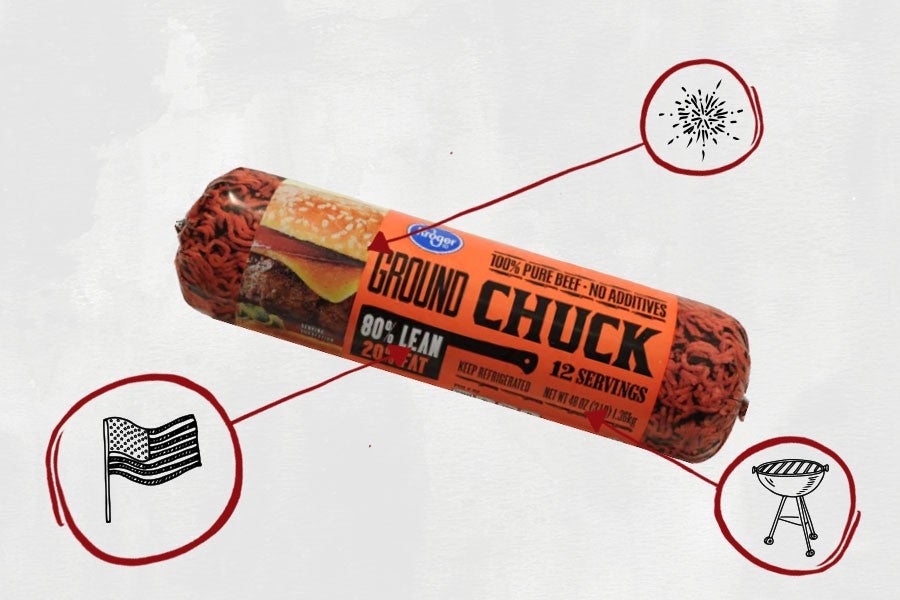We’re often told that you should never eat anything (or put anything on your body) if you don’t recognize everything on the ingredients list. But since most of us have no idea what xanthan gum or potassium benzoate are — or more importantly, what they’re doing to our bodies — we’re decoding the ingredients in the many things Americans put in (and on) themselves with the help of an expert.
This edition: Kroger Ground Beef Chuck, which is apparently made from just one ingredient, described as it appears on their website.
But before diving into the ingredients, here’s some distressing news: Last month, a Kroger supplier recalled more than 35,000 pounds of ground beef because it may have been contaminated with hard bits of plastic. How exactly this plastic found its way into the ground beef isn’t clear, but if you bought this product before that recall, throw it away or return it for a full refund.
With that, let’s get back to whatever else is hidden away in this ground beef!

The Ingredients
1) Ground Beef: It probably goes without saying in this column, but there’s much more to this single-ingredient list than meets the eye. For starters, products categorized as “ground beef” may contain skeletal muscle, skeletal trimmings, head meat and up to two percent cheek meat — without having to specifically list these ingredients on the label — according to the U.S. Department of Agriculture (USDA) Ingredient Standard List and Labeling Requirements for Ground Beef Products.
It’s also possible that a single package of ground beef may contain meat from a vast number of cows: In 2014, McDonald’s confirmed rumors that its beef patties can be made up of meat from more than 100 different cows, and a 2015 Washington Post article revealed that many supermarkets (and meat processing plants) use this same method.
Worse yet, ground beef may also contain a spattering of pathogens and actual shit, according to America’s Food: What You Don’t Know About What You Eat:
“A nationwide study by the USDA in 1996 found that 7.5 percent of the ground beef samples taken at processing plants were contaminated with Salmonella, 11.7 percent were contaminated with Listeria monocytogenes, 30 percent were contaminated with Staphylococcus aureus and 53.3 percent were contaminated with Clostridium perfringens. All of these pathogens can make people sick; food poisoning by Listeria generally requires hospitalization and proves fatal in 20 percent of the cases. In the USDA study 78.6 percent of the ground beef contained microbes that are spread primarily by fecal material.”
Admittedly, the USDA has since put more restrictions in place in an attempt to avoid such widespread contamination. According to recent food safety guidelines regarding the handling of ground beef: “Before 1996, the inspection of beef carcasses was by sight, touch and smell. With the passage of the 1996 Final Rule on Pathogen Reduction; Hazard Analysis and Critical Control Point (PR/HACCP) Systems, FSIS [Food Safety and Inspection Service] began requiring microbial testing in slaughter plants for E. coli.” But clearly, E. coli isn’t the only dangerous pathogen lingering in ground beef.
Finally, as Jean-Claude Setin, master butcher and owner of Le French Butcher in L.A., explained to me earlier this year, ground beef (and any other form of beef, for that matter) is riddled with antibiotics and hormones that aren’t listed on the ingredients label:
“While more and more commercial meats are claiming ‘no antibiotics,’ what they’re doing is putting it in the grain. They say, ‘Our animals aren’t treated with antibiotics or hormones,’ because they’re putting them in the grain — they’re not ‘treated’ with them; they’re being fed them.
“As a result, we’re eating meat that has steroids in it. We’re eating meat that has appetite enhancers in it. We’re eating meat that has sugar in it.”
Great.
The Takeaway
The meat industry should not be trusted, period — and nor should that Fourth of July burger.

